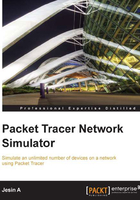
What this book covers
Chapter 1, Getting Started with Packet Tracer, starts with a short introduction of Packet Tracer, protocols supported by it, and explains its installation on Windows and Linux. After reading this chapter, users should understand the use cases and limitations of Packet Tracer and be familiar with the Packet Tracer interface.
Chapter 2, Network Devices, covers Cisco network devices such as routers, switches, and other generic devices such as bridges, hubs, repeaters, and WAN emulators. Network devices enable the end devices to communicate with each other. Configuring these devices from the config tab will also be explained. By the end of this chapter, readers will be able to understand and customize network devices with modules, and save these under Custom Made Devices. Readers will also be able to configure routers and switches using the config tab without using Cisco commands.
Chapter 3, Generic IP End Devices, explains PCs, laptops, and servers at large with a brief description on other end devices such as tablets and televisions. End devices are the ones used by end users, with desktops and laptops being the most common ones.
Chapter 4, Creating a Network Topology, explains different connectors, creating network topologies, and configuring them with Cisco commands. After testing the connectivity with complex PDUs, users will also use the simulation mode to analyze the packet flow.
Chapter 5, Navigating and Modifying the Physical Workspace, introduces the physical workspace in Packet Tracer. After reading this chapter, users will understand the physical limitations of wired and wireless devices. Physical workspaces are a great way to make topologies more realistic.
Chapter 6, Configuring Routing with the CLI, guides the users to configure static and dynamic routing. A router's job is to route traffic between different networks.
Chapter 7, Border Gateway Protocol (BGP), begins with a short introduction of BGP, explains the differences between BGP and other Dynamic Routing protocols, and ends with configuring BGP in Packet Tracer. BGP is a routing protocol synonymous with ISPs.
Chapter 8, IPv6 on Packet Tracer, explains using IPv6 with Packet Tracer. IPv4 has exhausted itself and the whole world is now migrating to IPv6. By the end of this chapter, the user will be able to assign IPv6 addresses to network and end devices, configure routing between IPv6 networks, and also configure a topology with both IPv4 and IPv6.
Chapter 9, Setting Up a Wireless Network, explains the wireless devices available in Packet Tracer and makes use of the physical workspace to demonstrate the range of wireless devices. Wireless networking is being implemented everywhere.
Chapter 10, Configuring VLANs and Trunks, explains how the user will be able to create VLANs, modify trunk links between switches, configure VTP to advertise VLANs, and use simulation mode to understand broadcasts ina VLAN environment. A VLAN is used to segment a broadcast domain.
Chapter 11, Creating Packet Tracer Assessments, covers the Activity Wizard available in Packet Tracer. Wouldn't it be great to create practical questions rather than the mundane "Choose the best/correct answer" ones? By the end of this chapter, users will be able to create timed networking scenario assessments.
What you need for this book
This book is about the software called Packet Tracer that is available for download from the Cisco Networking Academy website. This software is available for both Windows and Linux operating systems.
As of the release date of this book, the latest version of Packet Tracer is Version 6. You can always find the latest version at https://www.netacad.com/web/about-us/cisco-packet-tracer.